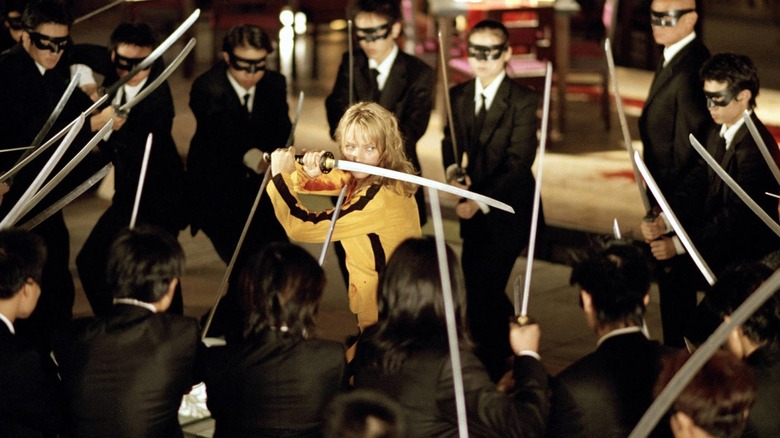Quentin Tarantino Did Endless Takes To Keep An Old-School Condom Trick In Kill Bill
Digital effects have made a lot of advances in the last few decades, but not everyone prefers a computer-generated spectacle. Filmmakers like Quentin Tarantino prefer the grittier, traditional option — even when the practical effect is less practical than CGI. The "Kill Bill" director went to extreme lengths to avoid creating his gore in post. One effect, in particular, cost him hours on set, but his commitment to his creative vision paid off in the end.
"Kill Bill" might be the most violent movie in Tarantino's filmography, which is saying a lot. The film's most unforgettable moments were filled with blood and action, but what makes a fight scene really great is the sum of its parts. The director had a keen eye for details, and even the quick deaths of minor characters were shot to perfection. One such moment took the most takes that Tarantino had ever done on a single shot.
"We were doing it the old-fashioned way, the Chang Cheh way," he explained in an interview with Robert Rodriguez for El Rey Network. "You take a Chinese condom and you fill it full of the phony blood and then the actors just have it in their hand, and so when slices through air slice the sword the actor just squeezes the Chinese condom and the blood explodes and it looks awesome."
In one over-the-shoulder shot during the fight scene between The Crazy 88 and Uma Thurman's "The Bride," Tarantino had the idea to use this condom effect to simulate Thurman slitting an assassin's throat. Unfortunately, he failed to consider the laws of gravity. "After Uma [slits the girl's throat] and she grabs her throat, you're gonna see like the blood go up," Tarantino said, pointing out the blood spatters in the shot. "Every time we did it the blood went down."
The spirit of Chang Cheh kept Tarantino going
Tarantino was committed to sticking with his old-school condom trick, even when things started to look hopeless on set.
"We kept doing it again and doing it again," the filmmaker recalled. "Take 22, Take 23 — we've changed her clothes three different times. So now she's off for the fourth change and walking by myself. One of those dark moments of the soul," he said. But just when things were looking bleak, the "Pulp Fiction" director caught a second creative wind.
"I swear it was as if Chang Cheh came to me and he said, 'Quentin hang in there,'" Tarantino claimed. "'It's going to happen — it has to happen one way or it. You're due. It's going to go up at some point. You can't quit hang in there. Do it six more times, see what happens.' And then like you know maybe the fifth time or so then it finally did it the right way." All told, that single shot took 34 takes.
Chang Cheh is the late director of the 1970 kung fu movie "Vengeance," which Tarantino has cited as a major influence for "Kill Bill," per Time. The film guided his choice to use practical effects instead of digital ones.
"That s*** looks good, but it looks like a computer did it," he said of CGI in a 2002 interview. "I'd rather have it look good and look like a cool '70s thing."
The takes were all worth it
It's no secret that Tarantino prefers a stylistic choice to a realistic one, and his gore is no exception. Even when it comes to blood, the auteur had a very specific vision that harkened back to his primary inspiration for "Kill Bill" — martial arts movies.
"I'm really particular about the blood, so we're using a mixture depending on the scenes," he told Time Magazine. "I say, 'I don't want horror movie blood, all right? I want Samurai blood.' You can't pour this raspberry pancake syrup on a sword and have it look good. You have to have this special kind of blood that you only see in Samurai movies."
Tarantino's perfectionism might cost him a lot of time on set, but it's ultimately why he's been able to maintain such a consistent and distinct style in all of his work. Every shot, no matter how fleeting, is an opportunity to innovate. Tarantino didn't miss a single opportunity to be creative, and he wasn't afraid to be bold — as long as he used protection.


